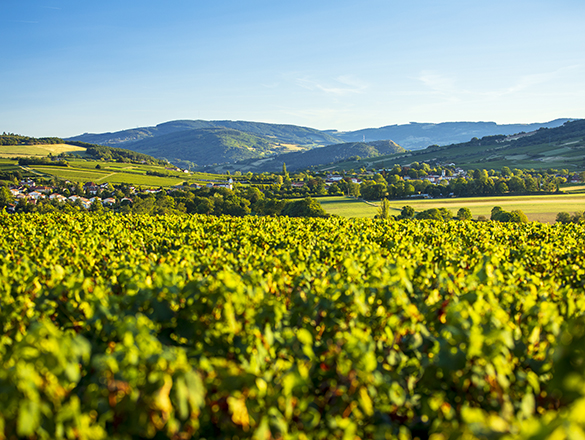
The vineyards of Bourgogne produce some great wines with a historical and international reputation. However, the region is not simply limited to its iconic appellations. In addition to its Village Premier Cru and Grand Cru AOCs, it also produces a range of wonderful Régionale and Village appellations to explore.
You will also find a full list of the Bourgogne’s Climats and lieux-dits on this page.
Check out the complete list of the 84 Bourgogne appellations.
However, your exploration has only just begun. Bourgogne wines have never before offered such high quality. Besides our range of internationally celebrated wines, try some of our lesser-known appellations where there are lots of surprises in store.
And for a fun way to find out more about the wines on offer, try out our “Which Bourgogne wine is right for me?” quiz, or check out Bourgogne Maps to take an interactive tour of the region.
Regional Appellation
VIGNOBLE DU MÂCONNAIS
31 juillet 1937
White: Chardonnay
Red and rosé: Gamay
Area under vine:
White: 53 hectares
Red and rosé: 7 hectares
Note: Average over three years 2016-2018
An additional geographical denomination that is part of the Régionale Mâcon appellation in the Mâconnais. According to the 2005 specifications rules, the name Mâcon-Verzé refers to white, red, and rosé wines grown within a defined area in the village of Verzé.

The whites have a deep golden yellow color, and on the nose, trigger a sensation of aromatic richness without exuberance. They present a lovely olfactive intensity, with clear aromas of grapefruit and white forest blossom like acacia. In the mouth, fine minerality results in a very rigorous profile without losing any of indulgence.
Located in a wide valley of west-facing slopes that is perfectly suited to the Gamay grape, Mâcon-Verzé produces red wines that reflect this with a delightfully intense dark ruby color. Morello cherries, red berries, and sloe brandy are all expressed spontaneously, making these wines very accessible to amateur wine lovers. Indulgent and silky in the mouth, they are a fine example of red Mâcon wines.

White: For a perfect flavor combination given the liveliness of this wine on the tongue, opt for an appetizer like a creamy leek tart or risotto verrine. Then allow its acidulated structure to cut through the parsley butter of razor fish à la plancha, gratinated oysters, or snails cooked in garlic butter.
Serving temperatures: 10-11°C as an aperitif, 11-12°C with food
Red: With its aromatic opulence and fleshy mouth, this wine is a remarkable companion with more fibrous meat dishes such as duck ravioli or braised côte de bœuf (ideally from the Charolais). For wine-marinated dishes, choose a hot year such as 2018, which will help soften the acidity of the sauce in a bœuf bourguignon or a snail meurette. To finish a meal, try a washed-rind cow’s milk cheese that’s not too old, or something drier like a Palet de Bourgogne or a Cendré de Vergy, to match the freshness of the Gamay.
Serving temperature: 14-15°C

In the center of the large Mâconnaise valley, the vineyards of Mâcon-Verzé extend to the communal boundaries to the north and south, where the appellations of Mâcon-Igé and Mâcon-La-Roche-Vineuse respectively begin.
Verzé grew up around a Roman settlement which was cut through by the stream of Talenchant, whose waters then fed into the moat of the medieval fortifications erected by the canons of the Cathedral of Saint-Vincent de Mâcon, part of which is still visible in the center of the village.
Its winegrowing reputation was first recorded in 1670 by the king’s tax inspectors who noted that: “There are vines here producing wines that are not bad.”
In the 1960s, Verzé was in the front line of a plan to improve the quality of the wines, although at the time, the infrastructure in the wineries was not yet suited to new packaging methods. By installing a collective bottling line in the winery of the Château de Vaux, the winemakers of Verzé and their coworkers in the cooperative union contributed significantly to distributing labels, key vectors in boosting the notoriety of the Mâconnais AOCs.

The vines of Verzé are mainly found on the long west-facing slope at between 280 and 410 meters above sea level in the plots of Chanteperdrix, Charnay, and Jobeline, beneath La Grande Chassaigne at 482 meters above sea level, and Mont Chevreuil at 464 meters above sea level, these reliefs separated by the valley of the Talenchant. To the east, the short and steep hillside of Bois de Verzé is home to vines that grow at between 270 and 345 meters above sea level (La Chevrière, Essart), in a temperate climate unique to the central Mâconnais.
As the long valley of Azé-Igé continues, Verzé offers limestone massives and soft marl by turns. The western slope and reverse side (Vaux-Verzé) are composed of a fossil-rich Bajocian pavement that dates back 170 million years, made of crinoidal limestone and limestone with polypier debris, sometimes with iron-rich veins and planted with Gamay. The foot of the slope and the slope itself combine white marl and limestone from the Upper Jurassic, dating back between 140-160 million years ago, with soils of varying depth.
